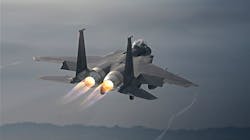Air Force orders eight new F-15EX jet fighter aircraft with advanced avionics, navigation systems, and radar
WRIGHT-PATTERSON AFB, Ohio – Combat aircraft designers at the Boeing Co. will build modernized versions of the 1970s-vintage F-15 jet fighter for the U.S. Air Force as a way to augment the new F-35 joint strike fighter with plenty of fire power on an affordable budget.
Officials of the Air Force Life Cycle Management Center at Wright-Patterson Air Force Base, Ohio, announced a potential $22.9 billion contract Monday to the Boeing Defense, Space & Security segment in St. Louis to design and build the F-15EX jet fighter.
The contract allocates an initial $1.2 billion for eight F-15EX aircraft, including design, development, integration, manufacturing, test, verification, certification, delivery, sustainment, and modification of F-15EX aircraft, as well as spares, support equipment, training materials, technical data, and technical support.
The first two F-15EX jets are under construction at the Boeing factory in St. Louis, and are scheduled for delivery next year.
The F-15EX is based on the F-15 Advanced Eagle that Boeing is building for the air forces of Qatar and Saudi Arabia, which has a fly-by-wire flight control system, digital electronic warfare (EW) suite, an infrared search and track (IRST) system, and the Raytheon APG-63(v)3 active electronically scanned array (AESA) radar.
The F-15EX carries more weapons than similar fighter aircraft, and will be able to launch hypersonic weapons that are as large as 22 feet long weight as much as 7,000 pounds, Boeing officials say. The F-15EX also is following the U.S. Department of Defense (DOD) DevSecOps initiative to develop secure, flexible, and agile software and an open-systems avionics architecture.
The F-15EX will be a large, powerful, non-stealthy, twin-engine jet fighter able to carry a large air-superiority weapons payload. The plane will be able to carry as many as 22 AIM-9X Sidewinder and AMRAAM medium range air-to-air missiles.
It also will have a substantially more powerful mission computer than all existing versions of the F-15, new cockpit displays, a digital backbone, infrared search and track (IRST) system, the Raytheon APG-63(v)3 active electronically scanned array (AESA) radar, and the Eagle Passive Active Warning Survivability System (EPAWSS) -- an electronic warfare and threat identification system.
The F-15EX also will have terrain-following radar to enable the pilot to fly at a very low altitude following cues displayed on a heads up display. The targeting pod contains a laser designator and a tracking system with a 10-mile range. The plane also will have as many as 11 underwing weapons stations and digital Joint Helmet-Mounted Cueing Systems. The original F-15 jet fighter began development in 1967, and entered service with the U.S. Air Force in 1976.
Boeing subcontractors for the Advanced Eagle include Astronautics Corp. of America in Arlington Va.; BAE Systems in Arlington, Va.; Elbit Systems of America in Fort Worth, Texas; General Electric Aviation in Cincinnati; Honeywell Aerospace in Phoenix; Lockheed Martin Aeronautics Co. in Fort Worth, Texas; L3 Communications in Arlington, Texas; NAVCOM in Torrance, Calif.; Raytheon Technologies Corp. in Waltham, Mass. and Charlotte, N.C.; Collins Aerospace in Cedar Rapids, Iowa; and Teledyne Electronic Safety Products in Thousand Oaks, Calif.
Many of those same subcontractors likely will be involved in the F-15EX project. Pilots and mechanics who now operate the F-15 expect their switches to the F-15EX to take a matter of days instead of years.
On this contract Boeing will do the work in St. Louis and at Eglin Air Force Base, Fla., and should be finished by December 2023. For more information contact Boeing Defense, Space & Security online at www.boeing.com, or the Air Force Life Cycle Management Center at www.aflcmc.af.mil.
About the Author
John Keller
Editor-in-Chief
John Keller is the Editor-in-Chief, Military & Aerospace Electronics Magazine--provides extensive coverage and analysis of enabling electronics and optoelectronic technologies in military, space and commercial aviation applications. John has been a member of the Military & Aerospace Electronics staff since 1989 and chief editor since 1995.
